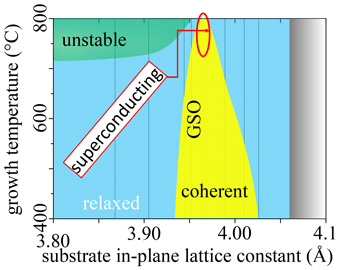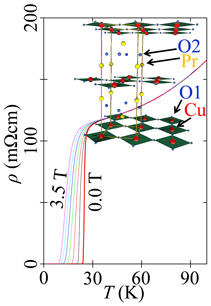As-grown Superconducting Pr2CuO4 Thin Films
The synthesis of electron doped cuprate superconductors, i.e. cuprates with square-planar coordinated copper, is entangled to a delicate problem arising from imperfection on the oxygen sub-lattice of the crystal. In particular, superconductivity in electron doped cuprates is known to appear only after an elaborate annealing process. While we have shown earlier that a proper tuning of the annealing process allows the induction of superconductivity even in the undoped cuprate [1], the thought of circumventing the annealing procedure by optimizing the growth conditions is tempting. Using molecular beam epitaxy, we have grown Pr2CuO4 (PCO) thin films coherently onto (110) GdScO3 substrates (Fig. 1) as a negligible lattice mismatch is to be expected. For coherently grown PCO thin films one may raise the synthesis temperature well beyond the point usually considered to result in disorder of the material. More importantly, it is now possible to further ease the oxidation power during the growth. We systematically varied the growth temperature, the oxidizing potential, and the substrate material in order to elucidate the very best combination possible. The results are circled in Fig. 1. Ultimately, PCO thin films grown at such conditions are superconducting and this is shown in Fig. 2 where we plot the temperature dependency of the resistivity of a PCO thin film coherently grown onto (110) GdScO3. At high temperatures, the PCO is metallic as the resistivity value monotonically decreases and superconductivity sets in at 27 K. In Fig. 2, we also show the resistivity response when a magnetic field is applied perpendicular to the CuO2 planes of PCO [2].
In summary, we have shown that superconducting PCO thin films can be synthesized in situ and such a method is important if one needs to avoid surface contaminations as is the case for angle resolved photoemission spectroscopy.
- [1] Y. Krockenberger et al. , Sci. Rep. 3, 2235 (2013).
- [2] Y. Krockenberger, M. Horio, H. Irie, A. Fujimori, and H. Yamamoto, Appl. Phys. Express 8, 053101 (2015).

|

|
| Fig. 1. Synthesis conditions for coherently grown PCO thin films. | Fig. 2. Resistivity vs temperature of a coherently grown PCO thin film without annealing. |